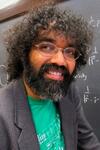Harsh Mathur
In this dissertation we study some low temperature phenomena in disordered conductors.
First we investigate the effects of spin precession on weak-localization. It is argued that the effects of spin-precession are analogous to the effects of weak magnetic fields; the latter are well understood to be a consequence of the Aharonov-Bohm effect. For the special case of spin-orbit coupling it is shown that the effects of spin-precession may be regarded as a consequence of the Aharonov-Casher effect, a newly proposed dual of the Aharonov-Bohm effect in which magnetic moments, such as electrons, are caused to precess by spin-orbit coupling even in the absence of classical forces. Based on this understanding, we present a quantitative method for calculating the effects of spin precession by virtually any mechanism. Our method not only agrees with earlier more specialized treatments of spin-precession (applicable for impurity spin-orbit scattering and Zeeman coupling to an applied magnetic field), it is also able to give a satisfactory quantitative account of recent experiments in GaAs inversion layers in which the spin precesses because the conduction band is spin-split.
Next, we investigate the spin-magnetism of mesoscopic conductors. Our purpose is to complement the extensive studies of orbital magnetism that have been undertaken. Small deviations from the macroscopic Pauli susceptibility, are found in the disorder averaged susceptibility both without interaction (in the canonical ensemble) and when interaction is taken into account. The sizes of the deviations, as a fraction of the Pauli susceptibility, are $\sim$($\Delta\sb{\epsilon}/kT\sp2)$ (non-interacting) and $\sim$($U + \lambda\sb{c})(\Delta\sb{\epsilon}/kT)$ (interacting). Here $\Delta\sb{\epsilon}$ is the mean level spacing, and U and $\lambda\sb{c}$ are interaction coupling constants. These effects vanish in the macroscopic limit, $kT \gg \ E\sb{c}$, where $E\sb{c}$ = $D/L\sp2$ is the correlation energy. We find the magnetization fluctuates from sample to sample, even when the samples are microscopically identical. The size of these statistical fluctuations is $\sim$ln($\Delta\sb{z}/kT)$, where $\Delta\sb{z}$ is the Zeeman spin splitting. Notice that it is independent of any material parameters. For a single sample, the magnetization plotted as a function of the applied field is expected to fluctuate reproducibly about linear Pauli behaviour. In these respects, these fluctuations are quite similar to the universal conductance fluctuations that are exhibited by mesoscopic conductors in transport measurements. Experimentally, however, it is much more feasible to measure fluctuations of a few conductance quanta, $e\sp2/h$, than it is to measure fluctuations of a few Bohr magnetons. We speculate that the best hope for measuring these fluctuations is by the detection of magnetization noise in a mesoscopic array caused by impurity hopping.
Finally, building up on the work on interacting spin magnetism, we undertake a more general study of interaction effects in the mesoscopic domain. Interaction effects in macroscopic diffusive samples have been studied in bulk samples (quasi 3D), films (quasi 2D) and filaments (quasi 1D). A naive extrapolation from macroscopic samples to mesoscopic grains (which are quasi 0D) of the quasi-particle lifetime and the density of states suggests a breakdown of Fermi liquid theory. However our calculations suggest that exactly the opposite happens: the quasi-particles are longer lived (lifetime $\sim E\sp2$ rather than the macroscopic $E\sp{d/2})$ and the density of states is no longer non-analytic at the fermi surface, as it is in macroscopic systems. (Abstract shortened by UMI.)
